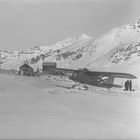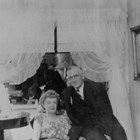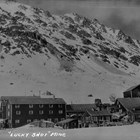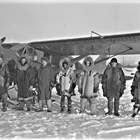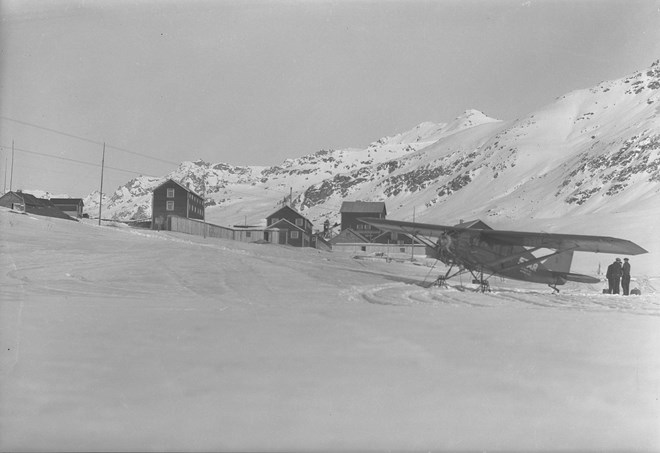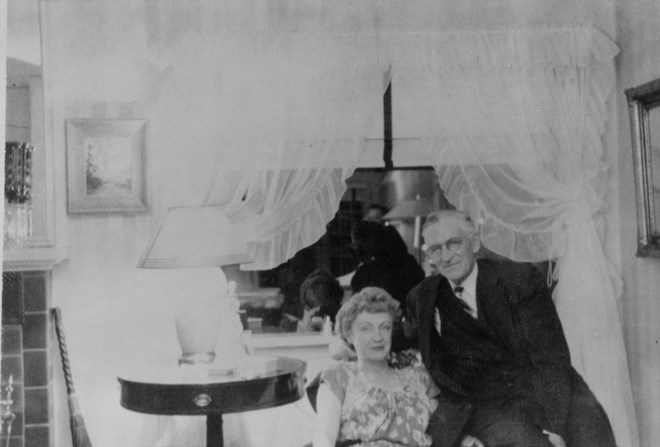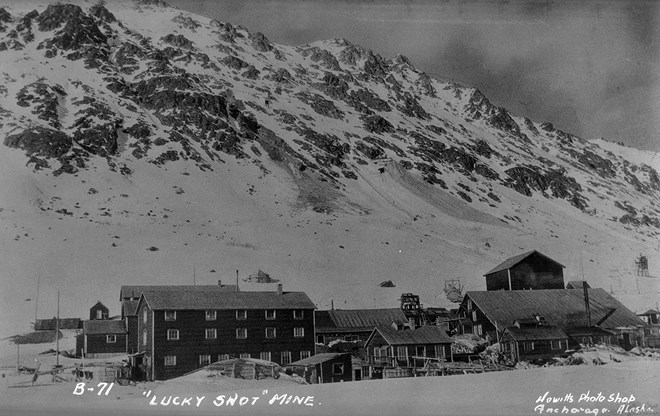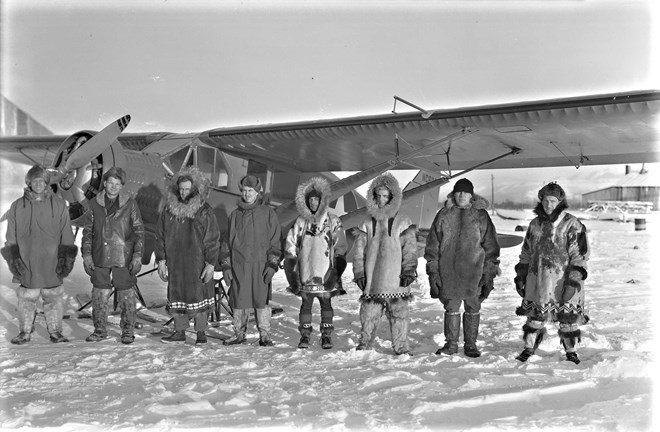Dunkle, Wesley Earl
1887-1957 | Mining Engineer, Geologist, Mine Owner, and Airline Pioneer
Welsey Earl Dunkle was one of the most knowledgeable and innovative mining engineers and geologists who were involved in Alaska’s gold and copper mining industry at the beginning of the twentieth century. From 1912 through the 1930s, Dunkle worked for several Guggenheim Corporation-related companies as a highly productive field exploration engineer or scout throughout Alaska and western Canada. He examined mining properties for the Guggenheims, J.P. Morgan, and other mining magnates. Dunkle is noted for his involvement in the discoveries of the world-class Jumbo copper deposit in the Wrangell Mountains in what would eventually become the Kennecott Mine. He also provided advice and expertise to mining enterprises in other parts of the world, especially in South America and Africa. He also became a leader in the field of commercial aviation, by developing Star Air Service, which later became Alaska Airlines.
In the preface to Wesley Earl Dunkle: Alaska’s Flying Miner (2003), economic geologist Charles C. “Chuck” Hawley, wrote: “During the fifty-year professional career, Dunkle set a pace in geology and mining that was difficult to follow. The pace accelerated in 1932 after Dunkle earned his pilot’s license, and he barely slowed down until his death in 1957.”1
Early Life
Wesley Earl Dunkle was born in Clarendon, Pennsylvania on March 4, 1887 to John Wesley Dunkle and Susan Amanda Dillon, the daughter of an Illinois minister. Dunkle was known as “Earl” to his family. Most of his old and close friends in later life simply called him “Dunk” or “Bill.”2 His father, attorney John Wesley Dunkle, was elected as county attorney in 1887 in Warren, an oil refining center in northwestern Pennsylvania, and the family moved there. Dunkle attended public schools in Warren and then the prestigious Sheffield Scientific School at Yale University, where he graduated with honors in 1908. He received a broad educational background with formal training in mineral engineering, metallurgy, economics, and chemistry at one of America’s best schools of mining. While at Yale, Dunkle belonged to the Pittsburgh Club and played a guitar in a banjo club. The 6’1” tall and very strong Dunkle also pulled on oar on the Yale crew, competing at least once against Harvard. He was elected vice-president of the freshman crew.3
Career
Dunkle’s academic education at Yale University was followed by what his biographer, Charles C. Hawley, described as an “intensive postcollege apprenticeship in geology and mining lasting from August 1908 until late 1911.”4 In August 1908, he was at the Canisteo open-pit mine in Coleraine, Minnesota, where he was working for the Oliver Mining Company. Dunkle gained additional experience in Ely, Nevada, where he worked at the McGill smelter before rustling a job as an assayer.5 In 1910, he was employed as a mining engineer in White Pine, Nevada for the Consolidated Copper Mining Company.6
Dunkle’s first position in Alaska was at the Guggenheim’s Beatson Mine on Latouche Island in Prince William Sound. He arrived in August 1910 to do assaying and surveying, but picked up valuable experience in detailed geologic mapping of mines—the Butte System—which is still the basis of underground mine mapping. By December 1911, he was promoted to field engineer. He reviewed mining properties for the Guggenheims and made geologic studies at the Kennecott Mines in the Wrangell Mountains. Dunkle also traveled widely in Alaska and western Canada for his employers. As a result of his research on the origin of the rich copper ore at Kennecott, he strongly recommended that the Guggenheim’s Alaska Syndicate acquire the Mother Lode claim, the continuation of the rich Bonanza ore body.7 Dunkle produced some of his best geologic work from 1912 to 1915, when he was part-time resident mine-geologist at Kennecott while continuing his scout work.
In the 1920s, Dunkle managed development operations for the Guggenheims at Mount Eielson near Kantishna and at the Mabel mine in the Willow Creek mining district.8 In 1929, Kennecott sent Dunkle to look at possible mining prospects in Africa, where he remained for nearly a year.
In 1930, Dunkle left Kennecott’s employ and opened the Lucky Shot Mine in the Willow Creek mining district in the Talkeetna Mountains, north and west of Palmer, Alaska, working with the Pardners Mines of New York. The existing mine had been severely damaged in a fire, and Dunkle supervised extensive renovations. The mine commenced operations during the winter of 1930-1931. The lode was very rich and the mine produced about one hundred ounces of gold daily, making it the “second or third largest lode gold mine in Alaska and one of the largest in the United States.”9 The Lucky Shot made Dunkle a moderately wealthy man.
Dunkle investigated other mining properties during the 1930s, usually with backing provided by Pardners Mines. He developed an incredibly rich lode deposit, called the Golden Horn, in the Flat (Iditarod) district and the Willow Creek placer at Flat.10 He was also involved in the Parks mercury mine in the Kuskokwim drainage. He ventured north into the Brooks Range, and also worked placer gold deposits in the Circle area and in the Yentna District. In 1936 he began to develop a gold lode mine, the Golden Zone, near Broad Pass west of the Alaska Railroad line on the way to Cantwell. Pardners Mines withdrew from Alaska in 1938. Thereafter Dunkle worked with a number of Alaskan investors, including Anchorage businessman Art Shonbeck and bankers E.R. Tarwater and Warren Cuddy, to raise money for the Golden Zone Mine. Some 880,000 shares of stock were sold to a total of about five hundred investors, most of them from the small town of Anchorage. During the 1930s, Dunkle employed at least one hundred people at any given time in his mines, to a maximum of two hundred.11
Interest in Aviation
Dunkle had his first airplane ride in 1928, flying from the Kantishna district north of Mount McKinley (now officially known as Denali) to Fairbanks. It had taken him five days to get to Kantishna from Fairbanks, traveling by train and then by dog sled. The return flight to Fairbanks took two hours. Dunkle took flying lessons in Seattle during the winter of 1931-1932, and helped persuade three flyers to come north to Anchorage, partly so he could continue his lessons. They were Jack Waterworth, Charles Ruttan, and Stephen Mills. They formed Star Air Service, with Dunkle as the principal financial backer. By late 1932 Dunkle had his license and had purchased his first airplane, a Curtis-Wright Travel Air, in New York. The flight west was harrowing; Dunkle crashed once in his hometown of Warren, Pennsylvania, disrupting a local football game, and nearly ran out of fuel several times while searching for airstrips on which to land. There were no charts (Dunkle followed road maps), often no landing lights, and no radio. Dunkle had the plane shipped to Anchorage, and used it for three years before hitting a tree while taking off from Lake Spenard. However dangerous, Dunkle found that using an airplane took days and weeks off traveling into the Bush to examine mining prospects. Dunkle became a very skilled (and very lucky) pilot.
In June 1934 Star Air Service flew the first commercial passenger flight from Anchorage to Seattle. It took seventeen hours of flying time spread over several days. However, most of Star’s service was in Alaska, in support of Dunkle’s various mining operations around the Territory. At one point mechanics took apart a bulldozer and shipped the parts by air over the Alaska Range and reassembled it at a mine. By 1936 Star owned fifteen aircraft, and was the largest air service in Alaska. It may have employed up to seventy-five people. Because of his understanding of aviation around the Territory, Dunkle was appointed one of four members of the Alaska Aeronautical Board. Dunkle successfully lobbied to have a channel dug between Lake Spenard and Lake Hood to allow more heavily laden float planes to take off; the project was completed in the winter of 1940-1941. By 1938 Star Air Service had become Star Airlines, which later morphed into present day Alaska Airlines.12
Later Mining Career
As gold increased in value in the late 1930s, so did Dunkle’s wealth. World War II created substantial problems for Dunkle, not the least of which was the fact that most of his gold mines were shut down as not being essential to the war effort. Dunkle switched his efforts to mining coal near the Golden Zone Mine. The coal was sent to Anchorage or Fairbanks where the expanding military used it to produce heat and power. Because coal was considered essential to the war effort in Alaska, seventy-five very reluctant soldiers were assigned to work as miners. Dunkle’s finances were adversely affected by the closure of his mines.
Dunkle’s attempts to re-open his mining properties after the war went poorly. During the Korean War he worked for the U.S. Army Corps of Engineers, initially as a low level draftsman. In the early 1950s, he submitted his name as a candidate for appointment as territorial governor of Alaska. Not receiving that post, he applied to become the president of the University of Alaska, which had a strong mining program. At the age of sixty-six he was considered too old. Dunkle’s second wife, Billie, had become a very effective lobbyist in Washington, D.C., which helped improve the family finances.
Dunkle also began to think of writing about his life and times in Alaska, and began assembling material. He was pulled away from this by his last mining venture, the development of a group of coal deposits along the Alaska Railroad in Broad Pass. He was last seen alive on September 29, 1957 at the Broad Pass station house, where he stopped before going to look for a spring to provide water for his coal processing plant. When he had not returned by the next day, a search was made and Dunkle’s body was found on October 4, 1957, where he had apparently collapsed and died of heart failure.
Personal Life
Dunkle had two families. In 1914, Dunkle married Florence Hull in Oberlin, Ohio after the culmination of a two-year Alaskan romance. He met Florence on one of his trips to the Cordova office of the Alaska Development and Mineral Company in the summer of 1912. Florence, a former teacher, had been hired as secretary to Stephen Birch, the Managing Director and later, President, of the Kennecott Mines Company. Florence and Wesley Earl Dunkle had two sons, Bill and John. Tragedy struck on April 12, 1931 when Florence Dunkle died after a lingering illness. Three years later Dunkle brought Mrs. F.A. “Billie” Borthwick Rimer, whom he met in Africa in 1929, back to Alaska. Billie was a first-class honors graduate in zoology from St. Andrews University in Scotland and had earned a Ph.D. in biology from the University of Cape Town. When Dunkle met Billie, she was teaching biology at the University of South Africa and had a two-year old daughter, Diana. They later married and had a son, Bruce.13
Endnotes
- Charles Caldwell Hawley, Wesley Earl Dunkle: Alaska’s Flying Miner (Boulder: University Press of Colorado, 2003), xi.
- Charles Caldwell Hawley, "Wesley Earl Dunkle (1887-1957)," Alaska Mining Hall of Fame Foundation, http://alaskamininghalloffame.org/inductee_list.php (accessed January 12, 2015).
- Charles Caldwell Hawley, Wesley Earl Dunkle: Alaska’s Flying Miner, 1-11.
- Ibid., 29-30.
- Ibid., 29-32.
- Wesley E. Sunkle [Wesley Earl Dunkle], 1910 U.S. Census, McGill, White Pine, Nevada, ED 79, page 6A, National Archives Microfilm Publication T624,Thirteenth Census of the United States, 1910, Roll 859, 1910 United States Federal Census [database on-line], http://ancestry.com (accessed November 2, 2014).
- Charles Caldwell Hawley, Wesley Earl Dunkle: Alaska's Flying Miner, 65-67; and Charles C. Hawley, “Wesley Earl Dunkle (1887-1957)," Alaska Mining Hall of Fame Foundation,
- Charles Caldwell Hawley, "Wesley Earl Dunkle (1887-1957)," Alaska Mining Hall of Fame Foundation.
- Ibid.
- Charles Caldwell Hawley, Wesley Earl Dunkle: Alaska's Flying Miner, 137-142; and "Wesley Earl Dunkle (1887-1957)," Alaska Mining Hall of Fame Foundation.
- See Chapter 10, “The Golden Zone,” in Charles Caldwell Hawley, Wesley Earl Dunkle: Alaska’s Flying Miner, 147-168.
- See Chapter 8, in Charles Caldwell Hawley, Wesley Earl Dunkle: Alaska’s Flying Miner, 87-134.
- Charles Caldwell Hawley, Wesley Earl Dunkle: Alaska's Flying Miner, 50 and 99.
Sources
The most authoritative source of information on Dunkle is Charles Caldwell Hawley’s biography, Wesley Earl Dunkle: Alaska’s Flying Miner (University Press of Colorado, 2003). This book is more than a biography, as it serves as an excellent source on the history of mining in Alaska. Hawley also provides an understanding of Alaska’s economic and social history during the period leading up to statehood (1912-1959). Hawley wrote a condensed version of Dunkle’s life in a biographical essay ("Wesley Earl Dunkle (1887-1957)," which focuses on his mining career, for the Alaska Mining Hall of Fame Foundation (http://alaskamininghalloffame.org/inductees/dunkle.php). John P. Bagoy has a short entry for Dunkle in Legends & Legacies: Anchorage 1910-1935 (Anchorage: Publications Consultants, 2001), 322-333. By Walter A. Van Horn and Bruce Parham, January 13, 2015.
Preferred citation: Walter Van Horn and Bruce Parham, “Dunkle, Wesley Earl,” Cook Inlet Historical Society, Legends & Legacies, Anchorage, 1910-1940, http://www.alaskahistory.org.
Major support for Legends & Legacies, Anchorage, 1910-1940, provided by: Anchorage Museum at Rasmuson Center, Atwood Foundation, Cook Inlet Historical Society, and the Rasmuson Foundation. This educational resource is provided by the Cook Inlet Historical Society, a 501 (c) (3) tax-exempt association. Contact us at the Cook Inlet Historical Society, by mail at Cook Inlet Historical Society, Anchorage Museum at Rasmuson Center, 625 C Street, Anchorage, AK 99501 or through the Cook Inlet Historical Society website, www.cookinlethistory.org.
